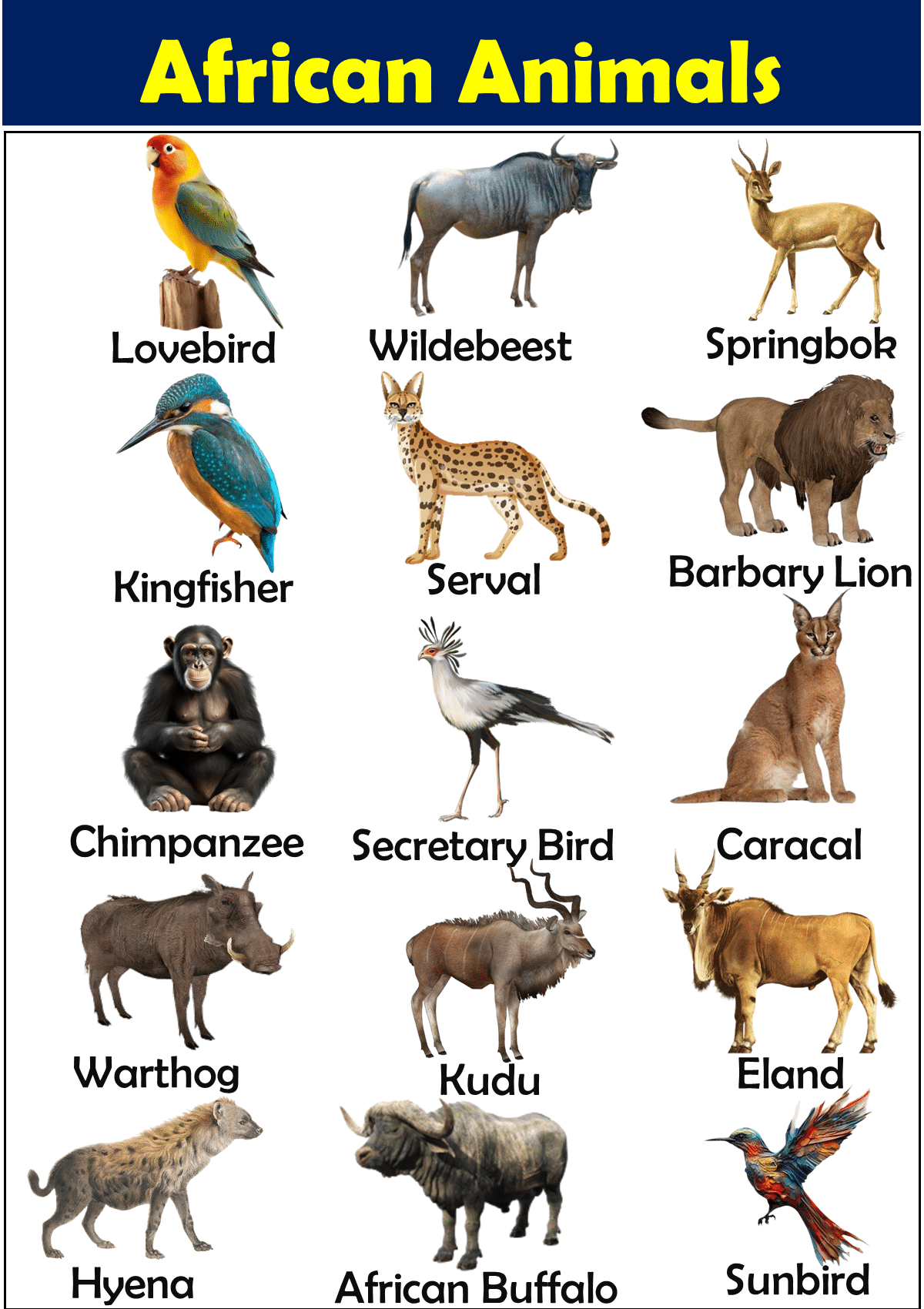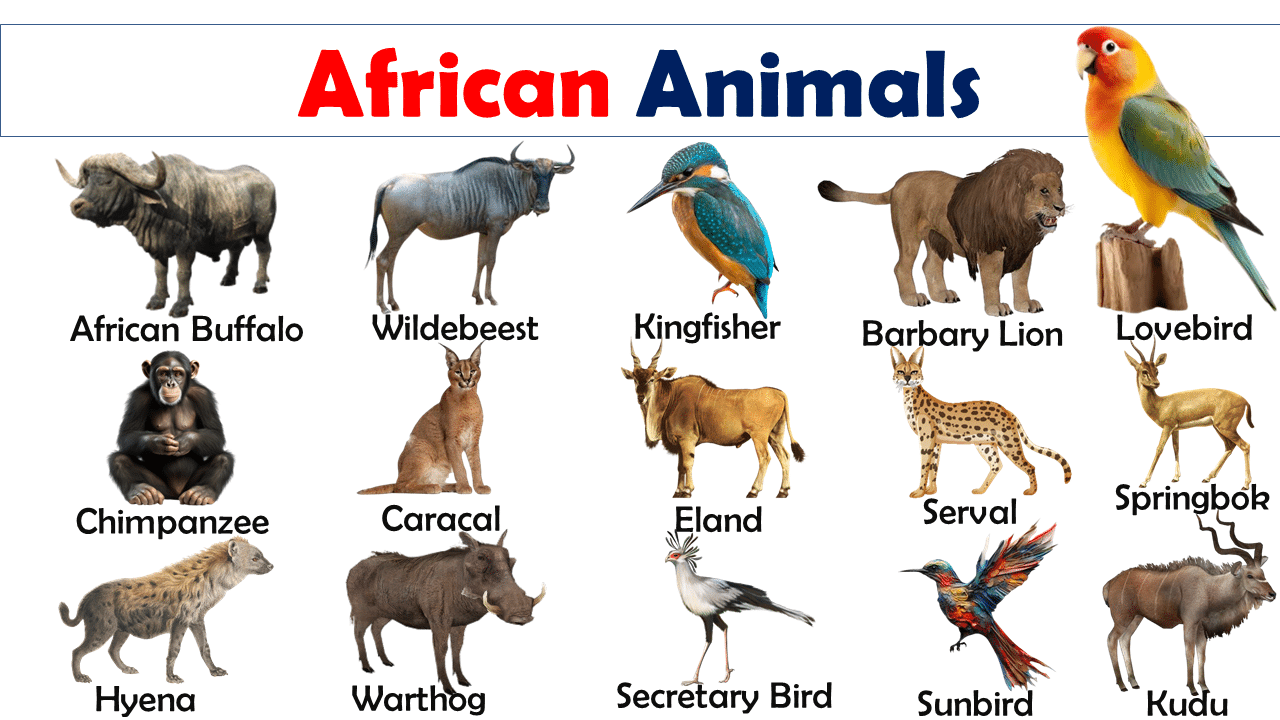Africa is a continent rich with wildlife, featuring some of the most iconic animals in the world. In this blog post, we’ll take a closer look at African animals, from the powerful lion, king of the savanna, to the tall and graceful giraffe. We’ll learn about where they live, what they eat, and some interesting behaviors they display. This journey will not only introduce you to the wonderful wildlife of Africa but also help you learn new and exciting English vocabulary words related to these amazing animals. Let’s embark on this wild adventure together!
What are African Animals?
Africa is known for its diverse ecosystems ranging from savannahs and tropical forests to deserts, which host a wide variety of wildlife. The continent is renowned for its large mammals such as lions, elephants, and rhinoceroses, but it also supports a myriad of other species including birds, reptiles, insects, and aquatic life.
List of African Animals
- African Elephant
- Lion
- Cheetah
- Leopard
- African Buffalo
- Rhinoceros
- Hippopotamus
- Giraffe
- Zebra
- Gorilla
- Chimpanzee
- Hyena
- Meerkat
- Wildebeest
- African Wild Dog
- Caracal
- Serval
- Warthog
- Impala
- Gazelle
- Kudu
- Springbok
- Eland
- Jackal
- Baboon
- Vervet Monkey
- Crocodile
- Ostrich
- Flamingo
- African Grey Parrot
- Marabou Stork
- Egyptian Goose
- Goliath Heron
- African Fish Eagle
- Shoebill Stork
- Hammerkop
- Secretary Bird
- Vulture
- Pelican
- Kingfisher
- African Penguin
- Nile Monitor
- Chameleon
- Puff Adder
- African Rock Python
- Scorpion
- Mongoose
- Fennec Fox
- Dung Beetle
- African Civet
- Genet
- Honey Badger
- Bushbaby
- Pangolin
- Aardvark
- Cape Buffalo
- Reedbuck
- Waterbuck
- Sable Antelope
- Bush Viper
- Spotted Hyena
- Barbary Lion
- Atlas Bear (extinct)
- Quagga (extinct)
- African Darter
- Bateleur Eagle
- Lappet-faced Vulture
- Lovebird
- African Harrier-Hawk
- Sunbird
Explore More Animal Vocab:
Zoo Animals | Safari Animals| Farm Animals

African Animals Vocabulary and Their Facts
1. African Elephant
The African elephant is the largest land animal, distinguished by its large ears that help regulate its temperature. These majestic creatures have complex social structures and are known for their intelligence and memory. Unfortunately, they are threatened by habitat loss and poaching for their ivory tusks, which has led to significant conservation efforts.
2. Lion
Known as the “king of the jungle,” lions are actually more commonly found in grasslands and plains. They are the only cats that live in groups, known as prides. Lions are apex predators, primarily hunting large ungulates. Their iconic roar can be heard up to 8 km away, serving as a territorial signal and a form of communication.
3. Cheetah
The cheetah is the fastest land animal, capable of speeds up to 112 km/h in short bursts covering distances up to 500 m. These adaptations make it a formidable predator. However, cheetahs have a low genetic diversity and require large territories, factors that contribute to their status as vulnerable.
4. Leopard
Leopards are versatile, solitary big cats known for their ability to adapt to various habitats, including savannas, mountains, and forests. They are distinguished by their well-camouflaged fur and unique spot patterns. Leopards are stealthy predators, often dragging their food into trees to avoid scavengers.
5. African Buffalo
The African buffalo is a robust species that prefers water-rich areas but can be found in semi-arid regions as well. Known for their unpredictable nature, buffaloes are considered one of the most dangerous animals to humans. They live in large herds and are a key target for big predators.
6. Rhinoceros
The rhinoceros, including both black and white species, is known for its large size and distinctive horned snout. Rhinos have thick protective skin and a reputation for being both solitary and aggressive. Poaching for their horns has critically endangered many rhino populations.
7. Hippopotamus
The hippopotamus is a large, mostly herbivorous mammal that spends much of its time in water to cool off. Despite their bulky frame and short legs, hippos can run fast and are highly aggressive, especially if provoked. They play a crucial role in their habitat by shaping river paths and dispersing seeds.
8. Giraffe
Giraffes are the tallest mammals on Earth, with their long necks and legs aiding them in feeding on the higher branches of trees. Their height also provides an advantage in spotting predators. Each giraffe’s coat pattern is unique, and they communicate through a variety of vocalizations and body movements.
9. Zebra
Known for their distinctive black-and-white striped coats, zebras are social animals that travel in large herds. Stripes may serve as camouflage and as a method to confuse predators. Zebras have excellent hearing and eyesight and can run at speeds of up to 65 km/h to evade predators.
10. Gorilla
Gorillas are the largest primates, residing in family groups led by a silverback, a mature male. They primarily inhabit the forests of central Africa and have a diet consisting mostly of vegetation. Gorillas are known for their strong social bonds and intelligent use of tools in the wild.
11. Chimpanzee
Chimpanzees are highly social and intelligent animals known for their ability to use tools, such as sticks to fish for termites. They share about 98% of their DNA with humans. Chimpanzees have complex social structures and can express a range of emotions.
12. Hyena
Often misunderstood, hyenas are not just scavengers but skilled hunters as well. They have strong jaws and a cooperative pack behavior that makes them successful predators. Hyenas communicate with a variety of sounds, including laughter-like calls.
13. Meerkat
Meerkats are small burrowing animals known for their upright posture. They live in large groups called mobs, and have a complex social structure with one alpha pair that breeds. Meerkats are highly vigilant and take turns acting as sentinels, watching for predators.
14. Wildebeest
Wildebeest, also known as gnus, are known for their annual migration across the Serengeti—a spectacular sight involving over 1.5 million animals. They graze in mixed herds with zebras for increased protection against predators. This migration is crucial for their survival, as it follows seasonal rain patterns.
15. African Wild Dog
African wild dogs are highly social animals with a pack life centered around a strict social structure. They are efficient predators known for their endurance running and cooperative hunting tactics. Unfortunately, they are endangered due to habitat fragmentation, human conflict, and disease.
16. Caracal
The caracal is a medium-sized wild cat known for its distinctive tufted ears and remarkable agility. It is a formidable predator that can leap high into the air to catch birds. Caracals prefer a solitary lifestyle and are primarily nocturnal.
17. Serval
Servals are medium-sized cats with long legs, large ears, and spotted markings. They are skilled hunters, using their acute sense of hearing to detect prey. Servals specialize in catching rodents in tall grasses, leaping vertically to pounce upon them.
18. Warthog
Warthogs are easily recognized by their large heads, tusks, and wart-like bumps. These pigs are not true hibernators but will seek refuge in burrows to escape the heat and predators. They are predominantly grazers and use their snouts to dig for roots and bulbs.
19. Impala
Impalas are medium-sized antelopes that can jump distances of up to 10 meters. This agility is vital for escaping predators. Impalas are social creatures that live in herds, which provides protection through safety in numbers. They are a key prey species for many predators.
20. Gazelle
Gazelles are small antelopes known for their speed and grace. They are found in various environments from sandy plains to savannahs. Gazelles are primarily grazers, but can browse during dry periods. Their high-speed sprints and sudden changes in direction help them escape from predators.
21. Kudu
The kudu, with its magnificent spiraled horns, is one of Africa’s most beautiful antelopes. They are browsers, feeding on leaves and branches of bushes and trees. Kudus are very alert and secretive, using thickets and forests as cover from predators.
22. Springbok
The springbok is a medium-sized brown and white gazelle, renowned for its dramatic leaping display called pronking. Springboks can live in dry areas and have been known to go for years without water, obtaining moisture from their food.
23. Eland
The eland is the largest of the African antelope species. Despite their size, elands are surprisingly agile climbers and are known to clear heights of up to 2.5 meters. They are slow runners but can maintain a steady trot for long distances.
24. Jackal
Jackals are small to medium-sized canids found in Africa, notable for their cunning and adaptable nature. They are omnivores, which allows them to exploit various food sources, from fruits and insects to small mammals. Jackals often form monogamous pairs and are vocal, particularly during the evening.
25. Baboon
Baboons are one of the world’s largest monkeys, with a dog-like face and powerful build. They are highly adaptable, living in various habitats and known for their ability to exploit human activities. Baboons are social creatures with complex hierarchies and strong family ties.
26. Vervet Monkey
Vervet monkeys are medium-sized primates known for their black faces and grey body fur. They live in highly social troops and are known for their intelligence and complex behaviors, including alarm calls specific to different predators, which suggests a form of language.
27. Crocodile
African crocodiles, including the notorious Nile crocodile, are some of the largest and most powerful predators in African waterways. They have an ancient lineage and display complex behaviors, including sophisticated hunting strategies and maternal care.
28. Ostrich
The ostrich is the world’s largest bird, famous for its long neck, long legs, and ability to run at speeds of up to 70 km/h. Despite being flightless, ostriches are highly adapted to terrestrial life. They lay the largest eggs of any living land animal.
29. Flamingo
Flamingos are known for their distinctive pink feathers, which are actually a result of their diet containing carotenoid pigments. They are social birds that live in large colonies and are famous for their synchronized breeding and feeding behaviors.
30. African Grey Parrot
African grey parrots are famed for their intelligence and ability to mimic human speech, making them one of the most popular avian pets. In the wild, they live in large flocks and can live up to 60 years. Their social nature and cognitive abilities are remarkably advanced for birds.
